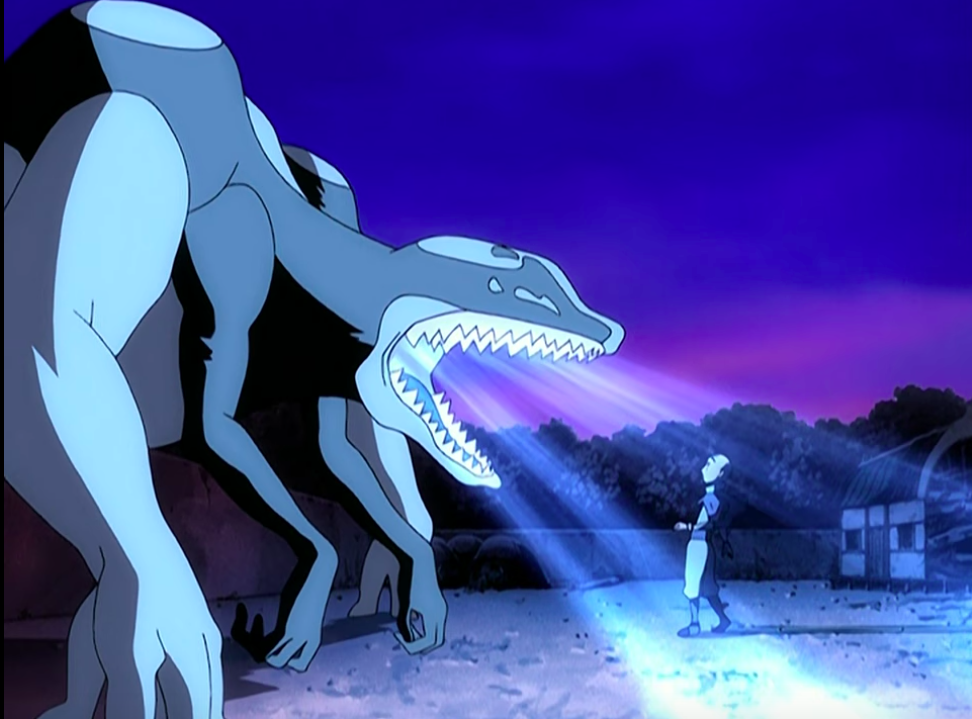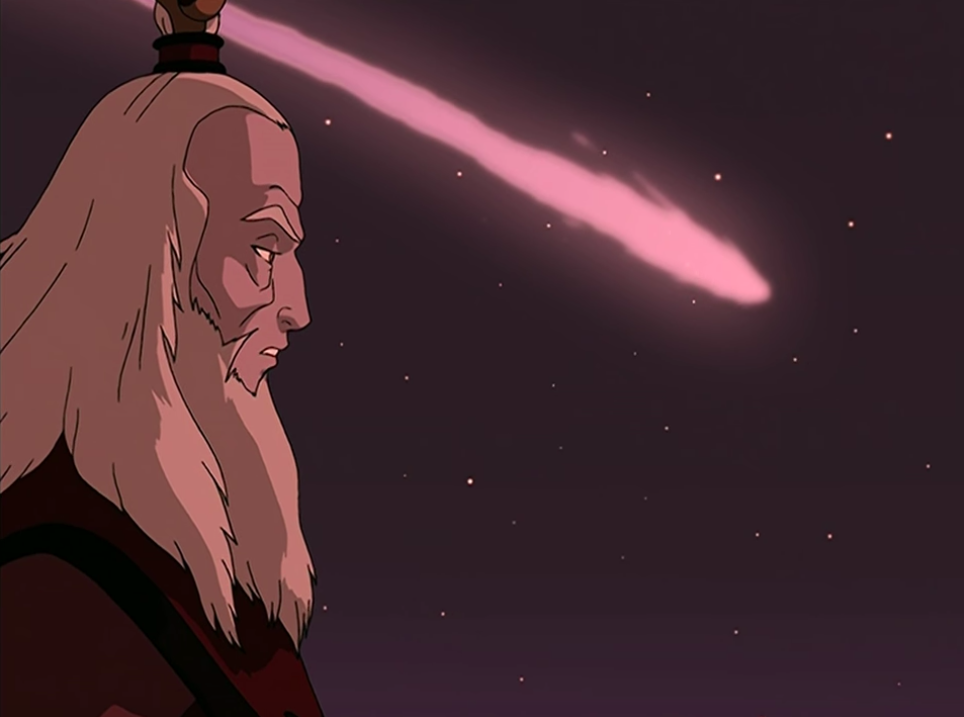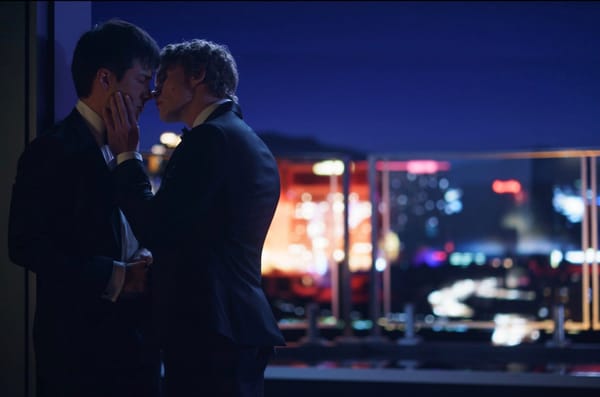Avatar: The Last Airbender: "Chapter Seven: The Spirit World" and "Chapter Eight: Avatar Roku"
In which we go big picture (and I defend the artistic constraints of ad-supported television)

(This is the third installment of my weekly recaps of Avatar: The Last Airbender, the Nickelodeon animated series that ran from 2005 to 2008 to much critical acclaim. I’ve never seen it! These recaps are only available to paid subscribers.)
“Chapter Seven: The Spirit World (Winter Solstice, Part 1)” (originally aired April 8, 2005)
“Chapter Eight: Avatar Roku (Winter Solstice, Part 2)” (originally aired April 15, 2005)

The first two-parter on a genre series is often a special thing. Yes, these shows often open with a double-sized “two-part premiere,” but then they typically settle into an adventure-of-the-week format designed to help audiences learn the rhythms of the show and its world. Avatar had a big premiere, then a bunch of smaller adventures. Now, it’s using its first two-part story to expand the size of the show’s world and history considerably.
Near the end of these episodes, I said to Cassie (the friend I am watching this series with) that I’m reasonably invested in the characters and somewhat invested in the plot. But what’s really grabbing my attention about this show at this point in time is the way that it feels like an amazing tabletop RPG setting, where the GM has sketched out just enough of the lore to be comfortable adlibbing when they have to come up with some wild shit off the top of their head.
The “Winter Solstice” two-parter, in other words, is a lore dump. It establishes a lot of the back story the series rests upon — though much of that back story was at least hinted at prior to this point — and then it introduces what appears to be the ticking clock for the rest of the show: the arrival of Sozin’s comet, which will give the Fire Nation so much power that they will be unstoppable. (And, okay, SPOILERS, I GUESS, the series finale is called “Sozin’s Comet,” so I can see where this is going.)
Lore dumps are rarely my favorite mode of genre storytelling, but they’re around for a reason. At a certain point, you need to let the audience in on some of the secrets you’re keeping, and it generally works best if viewers are learning things alongside the characters. Learning about Sozin’s comet matters to us on a metatextual level — now we know a major part of the series’ endgame! — but we only care about it because it’s new to Aang.
All of that probably sounds like basic storytelling stuff. To make the audience care, you have to make the characters care, right? But you’d be surprised just how many TV shows assume that what we’re tuning in for is the cool worldbuilding stuff, then forget to ground that worldbuilding in character to any real degree.

For instance, I’m rewatching the Netflix version of The Witcher and mostly enjoying it. The second time through the series, I’m better able to see how the pieces of the puzzle are meant to fit together and less frustrated by the opaqueness of the timeline. But I’ve realized a reason I struggled so much with the show the first go-round wasn’t the tricky timeline gymnastics as much as it is the fact that the characters too often feel like vessels meant to carry the audience through the world, so we can see all its high points. One character is a princess who gets lost in the woods, and really, she doesn’t seem to have much of a point to her story beyond “We need you to know what’s in the woods.” It’s reasonably engaging because I like the actor, but it takes a story that could be told in 10 minutes and stretches it across an entire season of television.
If I’m being honest, a big part of this problem in genre TV stems from the lack of meaningful structure imposed on streaming television episodes. Because the primary impetus of streaming TV is just to keep you watching, there’s at least a small amount of value in having viewers become buried in an endless array of tiny details, to send us scrambling to Wikipedia or whatever. If most of the story arrives in the last few episodes, well, sometimes that’s a value-add.
Avatar was made for ad-supported television, in a time when most TV still was ad-supported. It had a rigid episode length to adhere to. It had to figure out ways to keep kids watching across commercial breaks. And it had to figure out a way to get across vital information for understanding the series’ overarching plot in the face of all of that. Could that lead to some inelegant storytelling? Undoubtedly. But is that storytelling, at its best, tighter and more involving than almost any genre show being made right now? Yep.

The thing about ad-supported TV is that it often made TV better. Now that we can watch Avatar without commercials, the way in which its story ruthlessly and efficiently rolls forward is much easier to appreciate. There’s a beauty to the way it builds to a dramatic cliffhanger before each ad break, then resolves that cliffhanger as quickly as possible after the break, before making things worse for the characters.
This is not to say that great streaming TV isn’t possible, because it clearly is. It is to say that streaming allows TV creators to lean into some of their worst possible inclinations, unless they have a firm hand on what they want to do. Watching Avatar at the same time as The Witcher (I know, I know) makes clear how the former excels at stuff that the latter makes clunky and lugubrious.
And yet if you guessed that I don’t have a lot to say about this two-parter from all of the words I’ve dropped on TV structure — you’d be right! (Also, congratulations on reading me all these years through so, so many tangents.) The “Winter Solstice” two-parter seems all but designed to have viewers come back to it after watching the whole series to say, “Oh, cool, they were setting that up from the very beginning!”
The problem with these sorts of lore dumps is that they so often end up being so focused on the big picture that they let some of the smaller picture stuff slide. In this case, the show leans into what’s shaping up to be its worst tendency in the early going: Katara and Sokka are reduced to reactionary agents, following Aang around and trying to save him. There’s nothing wrong with that every so often. Aang, after all, is the show’s protagonist, and he’s the goldang Avatar. It would stand to reason that his dramatic stakes would be higher than those of his non-Avatar friends. But there are only so many times I can see Katara say, “Not without Aang!” as a situation is falling apart and she wants to save her friend.
The first of the two episodes has some neat lifts from Miyazaki, with what amounts to a cover version of Spirited Away in places. (The Hei Bai spirit, revealed ultimately to be A GIANT PANDA THAT AANG SOMEHOW DOESN’T ADOPT, is like a weird combination of the stink spirit and No-Face from that film.) And I like the idea of Aang acting as a bridge between the spirit world and ours, even if the show leaves the implications of this just a bit vague.
The second episode is probably slightly better as a story, while being plagued by poorly staged action sequences, which remains a problem at this stage of the series. The bit in the first episode where Uncle Iroh escapes from his captors was the first time I felt like the series had figured out a way to make the powers of bending interesting on the level of staging an action sequence, but the big showdown with the Fire Nation sages in episode two is yet another indifferently staged sequence.
Fortunately, all of the things I’m complaining about here are things that are easily fixed. Sharpening up action sequences usually just requires spending more time staging action sequences, and figuring out better ways to use Katara and Sokka will arrive naturally as the show steps away from following Aang as heavily as it does. Given how sharp the storytelling and worldbuilding have been so far, I have a lot of faith that the series will get there sooner, rather than later.

Other thoughts I thought:
- Sokka’s storyline where he gets trapped in the spirit world is handled so perfunctorily that I would forget it was happening even after a character would be, like, “Sokka’s trapped in the spirit world!!”
- Jason Isaacs’s work as Zhao is so chilling and good. He’s a terrific voice actor, and I’m pleased the show called on him when he was still mostly known for playing Lucius Malfoy and Captain Hook. (Then again, “Lucius Malfoy and Captain Hook” are pretty good comparison points for Zhao.)
- The way in which Aang tricks the Fire Nation folks into opening up the temple for him is pretty neat. That’s all I have to say, really: It was neat!
- Do you suppose that the famed streaming device is named after Avatar Roku? I am just going to assume it is and not look this up.
- Appa taking a gigantic nap after being besieged by Fire Nation ships is exactly what I would have done.
- Along those lines: It’s very kid show logic that the ships just stop firing on Appa once Aang and his friends have flown past. Apparently there were no catapults aimed that direction?
- Between the ghost dragon and the giant panda, these are two episodes where Aang could have really adopted some new animal friends and JUST. DIDN’T. Not that I’m mad about it or anything.
- I was originally going to build this article around the structural similarities between this show and early Buffy, but then this week ended up being a terrible time to do that. But you can probably guess what I would have written anyway! This series is hugely indebted to Buffy in the early going.
Next time: We cruise right past the season’s midpoint as we consider “Chapter Nine: The Waterbending Scroll,” “Chapter Ten: Jet,” and “Chapter Eleven: The Great Divide.” See you then!




